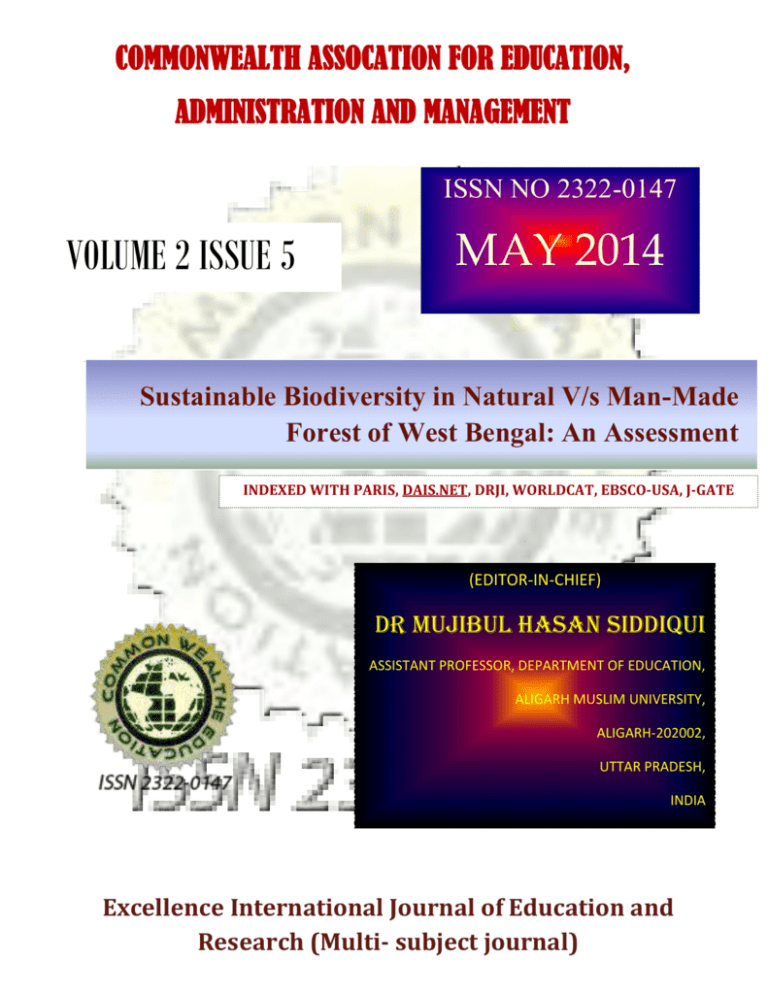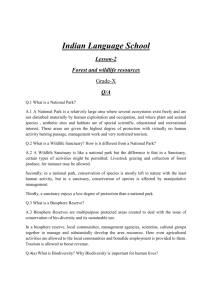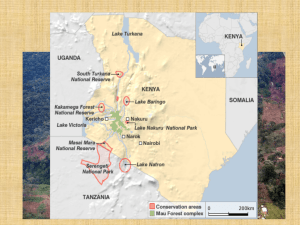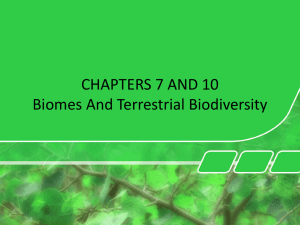DOC - Commonwealth Association for Education Administrator
advertisement

COMMONWEALTH ASSOCATION FOR EDUCATION, ADMINISTRATION AND MANAGEMENT ISSN NO 2322-0147 VOLUME 2 ISSUE 5 MAY 2014 Sustainable Biodiversity in Natural V/s Man-Made Forest of West Bengal: An Assessment INDEXED WITH PARIS, DAIS.NET, DRJI, WORLDCAT, EBSCO-USA, J-GATE (EDITOR-IN-CHIEF) DR MUJIBUL HASAN SIDDIQUI ASSISTANT PROFESSOR, DEPARTMENT OF EDUCATION, ALIGARH MUSLIM UNIVERSITY, ALIGARH-202002, UTTAR PRADESH, INDIA website: www.ocwjournalonline.com Excellence International Journal of Education and Research (Multi- subject journal) Excellence International Journal Of Education And Research VOLUME 2 ISSUE 5 ISSN 2322-0147 Sustainable Biodiversity in Natural V/s Man-Made Forest of West Bengal: An Assessment Subhankar Ghosh Research Scholar, Department of Education, Visva-Bharati, Santiniketan-731235 Emal id: sghosh.edu.vb@gmail.com Sk Mahim Ali Research Scholar, Department of Environmental Studies, Siksha-Bhavana, Visva- Bharati, Santiniketan-731235 Email Id: askmahim@gmail.com Pratik Bandyopadhyay M.Sc. Student, Department of Zoology, Centre for Advance Studies, Siksha-Bhavana, Visva-Bharati, Santiniketan-731235 Email Id: pratikrocks91@gmail.com Abstract Forests are the chief habitat for much of the world’s biodiversity. All over the world, planted or man-made forests stand for an increasing proportion of the forest area and also partly compensate for the loss of natural forest in terms of ecological functionand habitat for biodiversity. Now a day’s biodiversity is increasingly recognized as a very important factor for assessing environmental changes and sustainable developmental activities. It does a great job in the functioning of ecosystems. Not only that the well-known aspect of biodiversity is used astaxonomical arrangement of species in naked eye. To know the significance of biodiversity in terms of the differences between a Man-Made Forest and a Natural Forest, a comparative study has been done inBallavpur Wildlife Sanctuary (man-made forest)andChipkuthi Forest (natural forest).On the basis of the species richness and evenness of animals and plants, a large numberof species have been identifiedin both two forests. This paper deals with the species richness between theChipkuthi forestandthe Ballavpur Wildlife Sanctuary for measuring the sustainability of biodiversity. Excellence International Journal Of Education And Research (Multi-subject journal) Page 759 Excellence International Journal Of Education And Research VOLUME 2 ISSUE 5 ISSN 2322-0147 Keywords:Sustainable Biodiversity,Natural forest, Man-made forest, Species richness “Biodiversity is nature’s creation and for sustainable development this asset must be conserved by humankind for its own existence” -S.B. Mahato, Presidential Address, 100th ISC, 2013 Introduction Since the very pre-historic timeof the earthforests are significant for the global biodiversity &the condition of goods & services for humans&the regulation of the climate. It provides a range of ecosystem services.Biodiversity in a given area is usually evaluated through surveys quantifying species richness of different taxonomic groups. The correlates & cause of species diversity have long intrigued naturalists & ecologists (e.g., Clements 1916; Hutchinson 1959, Huston 1979, May 1988).The main three views of biodiversity delimiting its sense regarding the basic idea of biodiversity are - species diversity, genetic diversity & habitat diversity. The correct view of biodiversity depends on the characteristics of the problem situation. Production Forests with low biodiversity tend to be more susceptible to disturbance & environmental change than natural forests (Lugo, 1997; Carnus et al., 2006). But natural forests are among the largest partof species-rich environment on earth, making them critical reservoirs formany groups of biota (Gill 1995; Crozier et al. 1999)&also key stores of forest carbon (Metz 2007; Mackey2008). Forestmanagement will have its intense effects on biodiversity & human existence both in direct & indirect way. When man-made forests are managed to meet production targets they may fail to provide the adequate conditions for the establishment or persistence of more sensitive species (Endels et al., 2004; Fraterrigo et al., 2005). Moreover, protected areas (PAs), although the most effective way to conserve biodiversity (Terborgh et al., 2002), are by themselves inadequate to conserve biodiversity in the long-term (Rosenzweig, 2003). Approximately half of the earth’s closed-canopy tropical forest has already been converted to other uses, & the population of tropical countries, having almost trebled since 1950, is projected to grow by a further 2 billion by 2030 (Wright, 2005). Therefore, it’s very important to get information& predict about the sustainability offorest health in relation to biodiversity. Biodiversity & Sustainability Biodiversity is the richness &variety of life maintaining the health of the earth.It is the foundation of ecosystem services to which human well-being is intimately linked.The biodiversity of an ecosystem contributes to the sustainability of that particular ecosystem. Over the time period,sustainability of an ecosystem is the ability to maintain its structure & function in the face of external stress.Nature has its own way of maintaining balance in biodiversity. HighBiodiversity implies that there are more potential solutions to survival for new scenarios in the future. It also implies that more information about survival is stored in DNA that is active in Excellence International Journal Of Education And Research (Multi-subject journal) Page 760 Excellence International Journal Of Education And Research VOLUME 2 ISSUE 5 ISSN 2322-0147 the ecosystem. Therefore, if we have more &more biodiversity in ecosystem it will likely to be more sustainable for future life to survive unpredictable events.LowBiodiversityrefers to the low sustainability. The local loss of an essential species can disrupt ecosystem services for a long time. Changes in the interactions between species can also lead to negative impacts on ecosystem processes.It is essential for developing the capacity of ecosystem & providing support to minimize the biodiversity loss for sustainable development. Ecosystem Biodiversity Sustainability Fig-1:Sustainability and Biodiversity of an Ecosystem Objectives of the study 1. To know the differences of the ecosystem & biodiversity between natural forest &manmade forest. 2. To estimate which one is healthier &ecologically important forest. Methodology Study area The present study was conducted in two dry deciduous type forests viz., Ballavpur Wildlife Sanctuary (2 km2) &Chipkuthi Forest(3 km2) in West Bengal during December, 2013& January, 2014.BallavpurWildlife Sanctuary,a man-made forest (also a protected area) issituated near Santiniketan, West Bengal at approximately 23°41'N & 87°40'E with an average altitude of 56 m from sea level. It is an arid region &a part of western plateau region of west Bengal. Chipkuthi forest, a natural forest,is situated in Sriniketan, West Bengal at approximately 23°29´N & 87°42´E with an average altitude of 58.9 m from sea level. Prevalent Excellence International Journal Of Education And Research (Multi-subject journal) Page 761 Excellence International Journal Of Education And Research VOLUME 2 ISSUE 5 ISSN 2322-0147 soils in both the forests are hardy, rocky &sandy red lateritic soil made up of gravel& the temperature varies from 60C (in winter) to 440C (in summer) having maximum humidity 85% & minimum 55%. The average annual rain fall in the region is 137cm. Procedure We went to the Ballavpur & Chipkuthi forest in December, 2013& January, 2014through proper permission & enlisted the name of the plants& animals present in the twoforestsalso took the photograph. The unidentified small specimens (both plant & animal) were brought to the laboratory. The bigger specimens were identified by the photographs.Then comparison was done between the two forests for evaluated which was the healthy forest. Observation &Results 1. Ballavpur Wildlife Sanctuary The forest of Ballavpur Wildlife Sanctuary is a created forest having three water bodies. Soon after the Forest Department acquired this land, they started to raise block plantation in the degraded barren land area in a phase manner since 1954.Here mainly large treesare the producers. Table-1: Trees of Ballavpur Wildlife Sanctuary Sl.No. 1. 2. 3. 4. 5. 6. 7. 8. 9. 10. 11. 12. 13. 14. 15. 16. 17. Common Name Sal Sonajhuri Sissoo Kaju Minjiri Amloki Haritaki Bahera Mohua Jam Aam Tentul Rain tree Pea sal Chironji Palash Bot Scientific Name Shorea robusta Acacia auriculiformis Dalbergia sissoo Anacardium occidentale Cassia siamea Emblica officinalis Terminalia chebula Terminalia balerica Modhuca longifolia Syzygium cumini Mangifera indica Tamarindus indica Samanea saman Pterocarpus marsupium Buchanania lanzan Butea monosperma Ficus benghalensis Remark on the Occurrence & Distribution These are the dominant species of this sanctuary. They altogether cover almost 50% of total land area. These are the secondary dominant species cover almost 30% of total land area. These trees were planted to provide supplementary food to the spotted deer species that is the target species of this sanctuary. These tree species are found sporadically over the 2nd& 3rd phase of Excellence International Journal Of Education And Research (Multi-subject journal) Page 762 Excellence International Journal Of Education And Research VOLUME 2 18. 19. 20. 21. 22. 23. 24. 25. 26. 27. ISSUE 5 ISSN 2322-0147 Sirish Albizia lebbeck the sanctuary. Among them some were Arjun Terminalia arjuna planted to provide leaf fodder to the Gamar Gmelina arborea spotted deer e.g. Ficus Simul Bombax ceiba bengalensis&Azadiracta indica. Some Segun Tectona grandis trees are Sal associates such as Piyal, Neem Azadiracta indica Pea-sal, Arjun etc. altogether cover 20% Mahaneem Alianthus excelsa of land area. Kend Diospyros melanoxylon Jarul Lagerstroemia speciosa Lohakut Xylia dolabriformis Source: Forest Office, Ballavpur Wildlife Sanctuary, W.B. Apart from these tree species, some shrubs with medicinal value are quite pre dominant in these sanctuary. They are mostly found in lands near to the water bodies, they are- Kalmegh (Andrographis paniculata), Anantamul, Bantulsi, Surja sisir. Some more plants found in this sanctuary are -Vernonia cinerea, Gnaphalium indicum, Eclipta alba, Erigeron sp., Aerva lanata, Achyranthes aspera, Altarnanthera sp., Justicia diffusa, Rubus sp, Spathodea. Sp., Hygrophila auriculata, Borreria sp., Holarrhena Antidysenterica, Evolvulus alsinoides, Solanum nigrum, Alstonia scholaris, Ipomoea obscura, Solanum sisymbriifolium, Hybanthus enneaspermus,Croton bonplandianus, Cestrum sp., Calotropis gigantea, Melilotus albus, Lindenbergia indica, Pteris sp., Crotalaria trifoliate, Clerodendrum infortunatum, Cheilanthes sp, Sida cordata, Lantana camara.Among these some plant are medicinally & economically very important & some are used by the tribal people.Besides these some fungus like Lycoperdon sp., Agaricus sp., Termitomycessp., Ganoderma sp., Polyporus sp. etc. are present in this sanctuary. Table-2: Flora of Ballavpur Wildlife Sanctuary and Chipkuthi Forest Plants Trees Common Name Sal Sonajhuri Bandar Lathi Type 1 Sirish Sisoo Chhatim Type 2 Neem Mahagony Bat Ashwatha Numbers in Ballavpur Wildlife Sanctuary 1-3 4-9 ≥10 Numbers in Chipkuthi Forest 1-3 4-9 √ √ √ √ √ √ √ √ √ √ √ √ Remarks ≥10 √ √ √ √ √ √ √ √ √ √ Dipterocarpaceae Fabaceae Fabaceae Fabaceae Fabaceae Fabaceae Apocynaceae Semirubiaceae Meliaceae Meliaceae Moraceae Moraceae Excellence International Journal Of Education And Research (Multi-subject journal) Page 763 Excellence International Journal Of Education And Research VOLUME 2 Shrub Herb Under Growth SaproPhytes Kaju Jaam Khejur Type-1 Type-1 Neel Type-2 Type-3 Moss Lichen Algae Puff ball Type-1 Bracket fungi-1 Bracket fungi-2 Type-2 Type-3 ISSUE 5 √ ISSN 2322-0147 √ √ Anacardiaceae Myrtaceae Aerecaceae Solanaceae Malvaceae Fabaceae Euphorbiaceae Acanthaceae Dark redcapsules Have grey patches Green coloured , Spread on tree bark White globular Black globular Brown brackets √ √ Small white cups √ √ √ √ √ √ √ √ √ √ √ √ √ √ √ √ √ √ √ √ √ √ √ Yellow scaley Orange coloured protuberances Source: Field Survey at Ballavpur Wildlife Sanctuary and Chipkuthi Forest The Table-2 shows that the biodiversity of flora is more or less same in the two forests and no significant changes in the richness of flora is seen. Sal&Sonajhuri are the dominant flora in both of the two forests followed by Moss & Algae. b) a) Fig-2:Dominant Flora of Ballavpur Wildlife Sanctuary & Chipkuthi Forest a) Sal b) Sonajhuri Excellence International Journal Of Education And Research (Multi-subject journal) Page 764 Excellence International Journal Of Education And Research VOLUME 2 ISSUE 5 ISSN 2322-0147 Table-3: Faunaof Ballavpur Wildlife Sanctuary and Chipkuthi Forest Fauna Arthropoda Termite Beetle Fly & Mosquito Millipede Grasshopper Dragon fly Wood roaches Moth Common Name Ant-1 Kath pimpde Ant-2 Ant-3 Ant-4 Ant-5 Ant-6 Type-1 Type-1 Type-2 Bumble bee House fly Mosquito Type-1 Type-1 Type-1 Type-2 Larva-1 Type-1 Type-2 Type-3 Type-4 Type-1 Type-2 Type-1 Type-2 Type-3 Type-4 Numbers in Ballavpur Wildlife Sanctuary 1-3 4-9 ≥10 Numbers in Chipkuthi Forest 1-3 4-9 ≥10 √ √ √ √ √ √ √ √ Red with black strips √ √ √ √ √ √ √ √ √ √ √ √ √ Large black Thorax is red Grey Small black Small red Black winged Winged Large, with orange coloured head White with black spots √ √ Remarks √ √ √ √ Black Reddish brown Mosaic brown Grey Large red Small red Large green Small green √ √ √ √ √ √ Brown moth Brown butterfly Yellow butterfly Orange butterfly Excellence International Journal Of Education And Research (Multi-subject journal) Page 765 Excellence International Journal Of Education And Research VOLUME 2 & √ √ √ Type-5 Type-6 √ Type-7 Butterfly Spiders Reptilians Snake Ave Cuckoo Perching birds Deer Type-8 Type-9 Type-10 Larva-2 Type-1 Type-2 Type-3 Type-4 Type-5 Type-6 Type-7 Type-8 Type-1 Type-1 Bee eater Type-1 Sparrow Crow Chatter Chital ISSUE 5 √ √ √ √ √ √ √ √ √ √ √ √ √ √ √ √ √ √ √ √ √ √ √ Orange butterfly Orange butterfly with brown wing venations Orange butterfly with black spots on wings Blue butterfly White butterfly Grey butterfly Black spiny Brown Dark brown Brown with a pair of basal appendages Light coloured Black Immature white Green Very small black Brown rough skin Whitish √ √ √ √ ISSN 2322-0147 √ Black Brown Black Brown Brown spotted with antlers Type-1 √ Squirrels √ Ashy Indian Jackal Type-1 √ Source: Field Survey at Ballavpur Wildlife Sanctuary and Chipkuthi Forest a) b) Excellence International Journal Of Education And Research (Multi-subject journal) Page 766 Excellence International Journal Of Education And Research VOLUME 2 ISSUE 5 ISSN 2322-0147 Fig-3:Dominant Fauna in Ballavpur Wildlife Sanctuary & Chipkuthi Forest a) Chital deer (in Ballavpur Wildlife Sanctuary),b) Kath pimde (in Chipkuthi Forest) The Table-3 shows that the variety of fauna is very much higher in Chipkuthi Forest than the Ballavpur Wildlife Sanctuary. But Chital deer (Fig-3) is the only dominant species of Ballavpur Wildlife Sanctuary and not found in Chipkuthi Forest. Conclusion There are many measures of biodiversity where species richness (the number of species in a given area) represents a single but important metric that is valuable as the common currency of the diversity of life. But it must be integrated with other metrics to fully capture biodiversity.Here, the number of producers is much more than that of the consumers in both forest ecosystems. Animals, mostly dear & birds in Ballavpur Wildlife Sanctuaryare directly or indirectly depended on producers. Among the trees Acacia auriculiformis&Shorea robusta are most common in the two forests including plenty of mush-room.It is also found that the number of representative is goes up to the trophic level which is most common for all sustainable ecosystems. In this way it forms the biomes pyramid of forest ecosystem. But the diversity or variety of species is much more in the Chipkuthi Forestthan the Ballavpur Wildlife Sanctuary.The Chipkuthi Forest is denser than the Ballavpur Forest. Sothe study reveals that the Chipkuthi Forestis much healthier than theBallavpur Wildlife Sanctuary.Therefore, it can be said that the biodiversity of natural forests are much more sustainable than the man-made forests. References 1. Carnus, J. M., Parrotta, J., Brockerhoff, E., Arbez, M., Jactel, H., Kremer, A., & Walters, B. (2006). Planted forests and biodiversity. Journal of Forestry, 104(2), 6577. 2. Clements, F. E. (1916). Plant succession: an analysis of the development of vegetation (No. 242). Carnegie Institution of Washington, Washington. 3. Crozier, R.H., P. Agapow & K. Pedersen. (1999). Toward complete biodiversity assessment: an evaluation of the subterranean bacterial communities in the Oklo region of the sole surviving nuclear reactor. FEMS Microbiology Ecology,28. 325334. 4. Endels, P., Adriaens, D., Verheyen, K., & Hermy, M. (2004). Population structure and adult plant performance of forest herbs in three contrasting habitats. Ecography, 27(2), 225-241. 5. Fraterrigo, J. M., Turner, M. G., & Pearson, S. M. (2006). Previous land use alters plant allocation and growth in forest herbs.Journal of Ecology, 94(3), 548-557. 6. Gill, F.B. (1995). Ornithology.New York: W.H. Freeman and Company. Excellence International Journal Of Education And Research (Multi-subject journal) Page 767 Excellence International Journal Of Education And Research VOLUME 2 ISSUE 5 ISSN 2322-0147 7. Huston, M. (1979). A general hypothesis of species diversity.American naturalist, 113, 81-101. 8. Hutchinson, G. E. (1959). Homage to Santa Rosalia or Why are there so many kinds of animals? American Naturalists, 93, 145-159. 9. Metz, B. (Ed.). (2007). Climate Change 2007-Mitigation of climate change: Working Group III Contribution to the fourth assessment report of the IPCC (Vol. 4).Cambridge: Cambridge University Press. 10. Lugo, A. E. (1997). The apparent paradox of reestablishing species richness on degraded lands with tree monocultures. Forest Ecology and Management, 99(1-2), 919. 11. Mackey, B. (2008). Green carbon: the role of natural forests in carbon storage. Australia: ANU E Press. 12. May, R. M. (1988). How many species are there on earth?Science(Washington), 241(4872), 1441-1449. 13. Rosenzweig, M.L.(2003). Reconciliation ecology and the future of species diversity. Oryx, 37, 194–205. 14. Singh, Y.K. (2006). Environmental Science. Chapter 4 (pp137-160),New Delhi:New Age International (P) Limited. 15. Terborgh, J., van Schaik, C., Davenport, L., Rao, M.(2002). Making Parks Work: Strategies for Preserving Tropical Nature.Washington: Island Press. 16. Williams, L. D. (2005). Environmental Science Demystified. USA: McGRAW-HILL. 17. Wright, S. J. (2005). Tropical forests in a changing environment. Trends in Ecology & Evolution, 20(10), 553-560. Excellence International Journal Of Education And Research (Multi-subject journal) Page 768








